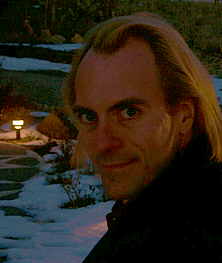Trygve.Com > Images > capturing the moon

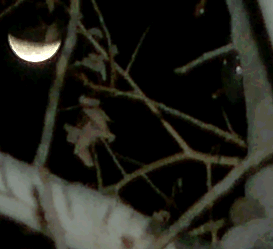
|
shooting stars
capturing the moon in full eclipse
|
On the night of January 20th, 2000, there was a total lunar eclipse, when the full
moon would pass into the shadow of the earth. It was a clear night out here at
the Treehouse and the stars were already bright against the deep black sky
before the lunar eclipse began.
|
I had just gotten the Kodak
DC-290 digital camera, which is almost identical
to the DC-260 that I'd been using, except for being a little faster when
processing pictures and being a little higher resolution (1700x1200 versus
1536x1024 for the DC-260). The three downsides of this camera are the
difficulty of attaching additional lenses and filters, either for
protection or for things like astrophotography, the somewhat low ISO
equivalence (ISO 100) which plagues most other digital cameras as well,
and the irritating
and inconvenient delays when it decides to display the "processing pictures"
message and refuse to take any more pictures for fifteen to thirty seconds.
Fifteen to thirty seconds hardly sounds like a big deal...unless, of course,
it just happens to be when you want to take a picture. On the other hand,
Kodak's DC-290, 265, and 260 all allow the use of the Digita scripting language
which greatly increases their flexibility and usefulness, especially in my
case, because 99.9% of the time, it's just me and my camera, and the script
language lets me program ahead of time what I want it to do, at which point
it can run the program unattended.
|
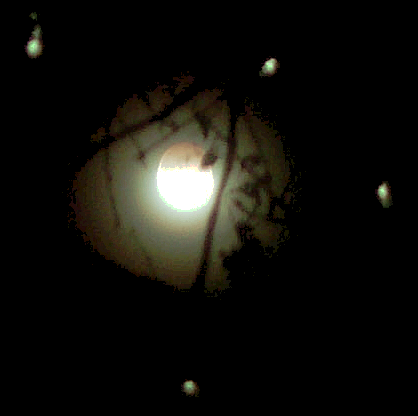
|
|
|
The first two pictures of the moon only partially eclipsed
were taken looking upwards through some of the trees in the courtyard; both
were taken with the focus set to "infinite" (the DC-290 will do single-spot
and multi-spot autofocus as well as the "fixed focus" setting I used for
these pictures). The difference is that the first was taken with the flash
on, whereas all the rest of the pictures on this page were taken with the
flash off.
Those little blobs of light around the moon in the second picture
are indoor/outdoor christmas lights in the tree and they are not on,
but are lit solely by the moonlight reflecting from the bulbs.
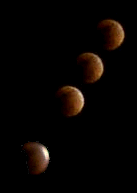
|
The series to the left was taken with the camera set on a tripod and
left to snap a picture every couple of minutes. The first picture (on
the lower left) was taken while setting it up to do the rest of the
series (hence the larger gap) just as the last of the moon was passing
into the earth's shadow. The shutter speed was locked at sixteen seconds
for these pictures and the ones below.
|
If you turn off the flash on the DC-290, it leaves it off, even if the
camera is turned on and off in the meantime. That's a definite plus
over the 260, which will turn the flash back on every time the camera
is powered up, no matter how many times you turn the flash back off.
That's even more annoying sometimes than it might seem, because these
digital cameras (like most) will turn themselves off if not used for
a couple of minutes. That would be less of a problem if it kept all
the settings you were using when it did turn itself off, instead of
requiring the user to set the flash mode again.
|
That's Max the gargoyle sneaking into this shot, lit by the red
glow of an eclipsed moon. In all the pictures taken during totality,
the camera did a pretty good job of capturing the reddish hue that
the moon takes on at times like these. (None of the colors were
changed to protect the innocent.)
|
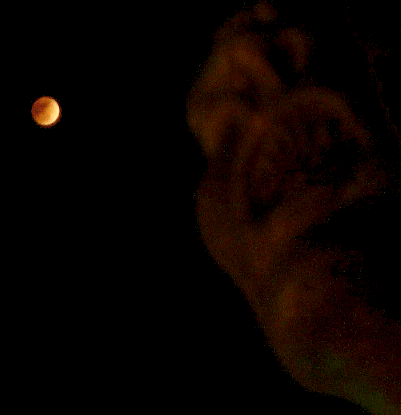
|

|
A while later, after the sun came up, these guys actually walked right up
to my front door. Now, that would have been a great shot, and it didn't
hurt the composition at all that there was also a hot air balloon overhead
and behind them. The launching area of the hot air balloons is on the
other side of the highway from me, so they go by a lot; I've had some low-flying
balloonatics sail through my yard twenty feet from me before--I can tell you
that this is very high up there on the list of surprising things to see when
you're not expecting it, because balloons can sneak up on you while you're
not looking their way.
|
But what did I say about how long thirty seconds is when the shot you
want to take is "right now"? Long enough for these guys to decide to
start walking away, so instead of deer at my front doorstep looking at
me, you get treated to a herd of deer backsides as they walk away.
This time, the delay was due
to the camera's "bootup time"; at least I got to see the close-up view
with the hot air balloon in the background and the deer got to see how
the DC-290 boots up.
|
I wonder if they would have stayed long enough for a couple of quick
pics if I'd signed up for some deer-scout cookies.

|
|






